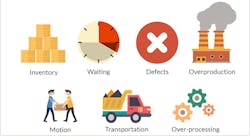Dealing with Productivity Loss in Maintenance Management
Like most businesses, manufacturing operations are organized according to processes or functions: production, finishing, shipping, etc., and every department contains hidden costs – costs that are not easily captured but still affect the results. When the management team is unaware of these expenses, they can become a part of the operation, affecting performance as well as costs and leading to problems that are hard to correct.
Maintenance departments are not exempt from this phenomenon, and can be particularly vulnerable to certain types of hidden costs.
Undetected expenses may have multiple causes — but one major source is known to nearly everyone. It is the “hidden cost” of unorganized and non-standard work practices that undercut productivity. It is a particularly troublesome issue because plant or shop managers often will not know the problem exists until they start to look for it.
Are you leaking resources due to unorganized work practices? How would you know? If so, how would you patch up your cost leaks and improve your overall maintenance performance? Read on to find out.
Problems stem from fundamentals — Because these are problems that are not easily uncovered, you must be proactive and take stock of your existing practices. Start with the fundamentals. Consider the seven sources of waste in lean manufacturing (some suggest there are even more …):
How can these wastes be observed in maintenance practices? Here are some examples.
Defects. A performed Work Order on some equipment did not fully repair the machine. Thus, some resources may have been wasted and more resources need to be committed.
Waiting. The affected equipment is down, but the maintenance work cannot commence (… because the maintenance technician is waiting on a part that must be delivered from an OEM, wait for a specific tool that is in use at the moment, wait for a safety manager to perform LOTO procedure, etc.) This results in a lot of idle time, which by definition is unproductive.
Inventory. Too many parts and tools are kept in an unorganized matter all over the site. Resources are tied up in parts that sit on a shelf, cluttering, and collecting dust. Lack of documentation and tracking leads to unnecessarily long searches for the right spare parts.
Transportation. The maintenance technician travels to affected equipment, ready to work. They realize that they need a tool that was left in the maintenance shop. Now they need to make an extra trip, wasting valuable time.
Each form of waste may be present in differing levels, adding up and potentially resulting in overtime, contractors, and extra manpower. There also can be ripple effects: If a technician is not diligent in his work practices, the costs add up quickly.
Finding the problems — Where exactly are you leaking money? The process of finding these costs is not always easy, but there are some proven techniques. A detailed review of training, work procedures, equipment, and inventory will likely be needed.
Traditional exercises — A work study may be useful in determining the costs that may hide in your maintenance practices. One option is to follow the technicians as they go about their work. Care must be taken to build trust before this happens. And this method has some serious downsides, as technician surely will try to be more productive when they know that they are being watched.
Another method of finding gaps in procedures is a value-stream mapping exercise. Gathering all team members togethers and drawing out the process steps can be illuminating for all involved.
The value of a CMMS — A Computerized Maintenance Management System also could be an asset when searching for inefficiencies. For example, you could investigate standard deviations on repeat jobs. Or, examine variation between technicians, equipment, or shifts. With proper CMMS reports, this data can be found quickly.
To find inventory issues, reviews will be needed of current inventory. Are parts sitting on shelves for long periods of time, or are they turning through quickly? Are all critical spares accounted for? How often is the work delayed because of a missing spare part. This may be a painstaking process.
Finding the problems is one matter though. Once some of these issues are uncovered, you must work to correct them.
Addressing the costs — Here are two ways to tackle productivity losses in maintenance management.
Culture change. In many facilities, the biggest barrier for improvement is existing culture. When you suggest that something needs to be improved, be it a switch to proactive maintenance or commitment to continuous improvement, you are letting people know that what they are doing right now is not good enough.
The improvement plan must take this into account. The benefits need to be clearly understood by all, and every party needs to buy-in. Change management is crucial, and all voices should be considered.
To promote buy-in, work on improving technician priorities first. In this way they should benefit immediately, which will help them to see the value of standardization and waste reduction.
Workflow standardizations. If the problem is unorganized and non-standard work practices, the solution presents itself: you need more workflow standardization.
Once maintenance processes are understood in detail, they can be standardized easily. Process standardization cuts down on variation and outlines the most optimal method in which a technician can perform the required task.
The most straightforward way to streamline maintenance work is:
• Write standard operating procedures;
• Write emergency operating procedures;
• Define clear ehs guidelines;
• Define clear lock out tag out procedures;
• Use a CMMS or standalone inventory-tracking software and standardize the way items are stored and pulled from inventory;
• Write maintenance checklists for all complex routine maintenance tasks.
There are two things to keep in mind when defining the above listed procedures. First, they should be written in collaboration with experienced technicians that have a good overview of current health of all assets, and how things work in practice on the production floor
The second thing is to insist on continuous improvement. People are not perfect and you might not get everything right the first time. Additionally, as technology grows and as new maintenance tools and techniques become available, your current procedures easily become obsolete.
The first step — Organizing an efficient maintenance department is not something that can be done overnight.
Identifying the waste is the first step. Though it may seem difficult, often these wastes are hiding in plain sight and uncovered with only a little effort — if you know where to look. This is why reviewing processes and maintenance data is an integral part of this effort.
Once the leaks are found, they must be addressed through a combination of policy, training, and culture shift. Though it’s not always easy, the process can be very beneficial. By rooting out waste in your maintenance procedures, you will improve the value of the maintenance department – as well as the entire operation.
Bryan Christiansen is the founder and CEO at Limble CMMS — an easy-to-use mobile CMMS software that takes the stress and chaos out of maintenance by helping managers organize, automate, and streamline their maintenance operations.
About the Author
Bryan Christiansen
CEO
Bryan Christiansen is the founder and CEO at Limble CMMS, a mobile CMMS software for organizing, automating, and streamlining maintenance operations.

